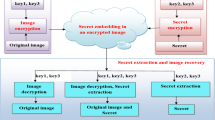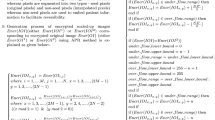Abstract
Cloud computing along with the Internet of Things (IoT) is proving to be an essential tool for delivering better healthcare services. However, maintenance, privacy, confidentiality, and security of Electronic Health Information (EHI) pose a huge challenge in telemedicine. The sharing of EHI with a remote doctor over the cloud is an important issue since the minute variation may lead to the wrong diagnosis. Despite the plethora of research in this field, there is an immense necessity to develop the algorithms for enhancing security in e-healthcare systems. In this paper, an innovative Reversible Data Hiding (RDH) scheme using Lagrange’s interpolation polynomial, secret sharing, and bit substitution for EHI security has been proposed. The cover medical image is sub-sampled, into four shares. Image interpolation is used to enlarge the subsamples, for hiding EHI. The secret information is processed using Lagrange’s interpolation polynomial before being embedded in the various cover image shares. The data is embedded into the interpolated sub-sampled shares at the locations pre-defined by the algorithm. The distributive nature of embedded data enhances the security of the proposed framework while maintaining reversibility. We show that only 75% of shares are required to obtain the whole embedded data and the undistorted cover image. The proposed scheme outperforms the schemes under comparison in terms of imperceptibility and payload. It can reversibly embed 163,840 bits (0.75 bits per pixel) with an average PSNR of about 52.38 dB. The average values of relative entropy, the difference in relative entropy, standard deviation, and cross-correlation are 7.3242, 0.0382, 65.0539, and 0.9838, respectively, for the first sub-sample. It shows an increase of about 3 dB for a payload of 1, 30,000 bits when compared to the state-of-art. Further, it is pertinent to mention that the proposed scheme has lower computational complexity and is hence useful for e-healthcare applications. Given all the attributes of the scheme along with its lower computational complexity, it is suitable for EHI security in a distributive environment like cloud computing.







Similar content being viewed by others
References
Bhardwaj, R.: An improved reversible and secure patient data hiding algorithm for telemedicine applications. J. Ambient. Intell. Humaniz. Comput. (2020). https://doi.org/10.1007/s12652-020-02449-2
Dang, L.M.; Piran, M.J.; Han, D.; Min, K.; Moon, H.: A survey on internet of things and cloud computing for healthcare. Electronics 8, 768 (2019)
Yangui, S.: A panorama of cloud platforms for IoT applications across industries. Sensors 20, 2701 (2020)
Swaraja, K.; Meenakshi, K.; Padmavathi, K.: An optimized blind dual medical image watermarking framework for tamper localization and content authentication in secured telemedicine. Biomed. Signal Process. Control (2020). https://doi.org/10.1016/j.bspc.2019.101665
Gull, S.; Loan, N.A.; Parah, S.A.: An efficient watermarking technique for tamper detection and localization of medical images. J. Ambient. Intell. Humaniz. Comput. (2018). https://doi.org/10.1007/s12652-018-1158-8
Patan, R.; Pradeep, G.S.; Ghantasala, R.S.; Gupta, D.; Ramachandran, M.: Smart healthcare and quality of service in IoT using grey filter convolutional based cyber physical system. Sustain. Urban Areas (2020). https://doi.org/10.1016/j.scs.2020.102141
Rajasekaran, M.; Yassine, A.; Hossain, M.S.; Alhamid, M.F.; Guizani, M.: “Autonomous monitoring in healthcare environment: Reward-based energy charging mechanism for IoMT wireless sensing nodes”, Future Gener. Comput. Syst. 98, 565–576 (2019)
Al-Turjman, F.; Nawaz, M.H.; Ulusar, U.D.: Intelligence in the Internet of Medical Things era: A systematic review of current and future trends. Comput. Commun. 150, 644–660 (2020). https://doi.org/10.1016/j.comcom.2019.12.030
Gull, S.; Parah, S.A.; Muhammad, K.: Reversible data hiding exploiting Huffman encoding with dual images for IoMT based healthcare. Comput. Commun. (2020). https://doi.org/10.1016/j.comcom.2020.08.023
Mansour, R.F.; Abdelrahim, EMd.: An evolutionary computing enriched rs attack resilient medical image steganography model for telemedicine applications. Multidimensional Syst Signal Proc 30, 791–418 (2019)
Kadhim, I.J.; Premaratne, P.; Vial, P.J.; Halloran, B.: Comprehensive survey of image steganography: techniques, evaluations, and trends in future research. Neurocomputing 335, 299–326 (2019)
Parah, S.A.; Sheikh, J.A.; Akhoon, J.A.; Loan, N.A.: Electronic health record hiding in images for smart city applications: a computationally efficient and reversible information hiding technique for secure communication. Future Gene. Comput. Syst., Elsevier, (2018). https://doi.org/10.1016/j.future.2018.02.023
Ahmed, A.; Latif, R.; Latif, S.; Abbas, H.: “Malicious insiders attack in IoT based Multi-Cloud e-Healthcare environment: a systematic literature review. Multimed. Tools Appl. 77, 21947–21965 (2018)
Meikap, S.; Jana, B.: Directional pixel value ordering based secret sharing using sub-sampled image exploiting Lagrange polynomial. SN Appl. Sci. (2019). https://doi.org/10.1007/s42452-019-0659-1
Ni, Z.; Shi, Y.Q.; Ansari, N.; Su, W.: Reversible data hiding. IEEE Trans. Circ. Syst., Vid Technol. 16(3), 354–362 (2006)
P. Y Tsai., Y. C. Hu, H. L. Yeh (2009), “Reversible image hiding scheme using predictive coding and histogram shifting,” Signal Process, 89(11):29–43.
Kim, K.S.; Lee, M.J.; Lee, H.Y.; Lee, H.K.: Reversible data hiding exploiting spatial correlation between sub-sampled images. Pattern Recogn 42(11), 3083–3096 (2009)
Li, X.; Li, J.; Li, B.; Yang, B.: High-fidelity reversible data hiding scheme based on pixel-value-ordering and prediction-error expansion. Signal Proc. 93(1), 198–205 (2013)
C. F. Lee, C. C. Chang, C. Y. Gao (2013), “A two-staged multi-level reversible data hiding exploiting lagrange interpolation,” 2013 Ninth international conference on intelligent information hiding and multimedia signal processing, IEEE, pp 485–488.
Peng, F.; Li, X.; Yang, B.: Improved PVO-based reversible data hiding. Digit Signal Proce 25, 255–265 (2014)
X. Qu X, H. J. Kim (2015), “Pixel-based pixel value ordering predictor for high-fidelity reversible data hiding,” Signal Process, 111:249–260.
Ou, B.; Li, X.; Wang, J.: Improved PVO-based reversible data hiding: a new implementation based on multiple histograms modification. J Vis Commun Image Represent 38, 328–339 (2016)
B. Jana B, : Reversible data hiding scheme using sub-sampled image exploiting Lagrange’s interpolating polynomial. Multimed. Tools Appl. 77, 1–17 (2018)
W. C. Kuo, D. J. Jiang, Y. C. Huang (2007), “Reversible data hiding based on histogram,” International conference on intelligent computing, lecture notes in artificial intelligence, vol 4682. Springer, Qing Dao, pp 1152–1161.
J. Hwang, J. W. Kim, J. U. Choi (2006), “A reversible watermarking based on histogram shifting,” International workshop on digital watermarking, lecture notes in computer science, vol 4283. Springer, Jeju Island, p: 348–361.
E. Varsaki, V. Fotopoulos,A. N. Skodras (2006), “A reversible data hiding technique embedding in the image histogram,” Technical Report HOU-CS-TR-2006–08-GR Hellenic Open University.
C. F. Lee, C.C. Chang, C. Y. Gao (2013), “A two-staged multi-level reversible data hiding exploiting lagrange interpolation,” 2013 Ninth international conference on intelligent information hiding and multimedia signal processing. IEEE, pp 485–488.
Huang, D.; Wang, J.: High-capacity reversible data hiding in encrypted image based on specific encryption process. Signal Proc.: Image Commun. (2020). https://doi.org/10.1016/j.image.2019.115632
Hurrah, N.N.; Parah, S.A.; Sheikh, J.A.; Turjman, F.; Muhammad, K.: Secure data transmission framework for confidentiality in IoTs. Ad Hoc Netw. 95, 1570–8705 (2019). https://doi.org/10.1016/j.adhoc.2019.101989
Malik, A.; Wang, H.X.; Chen, Y., et al.: A reversible data hiding in encrypted image based on prediction-error estimation and location map. Multimed. Tools Appl. 79, 11591–11614 (2020). https://doi.org/10.1007/s11042-019-08460-w
Wang, X.T.; Chang, C.C.; Nguyen, T.S.; Li, M.C.: Reversible data hiding for high quality images exploiting interpolation and direction order mechanism. Digit Signal Proc. 23(2), 569–577 (2013)
Ou, B.; Li, X.; Zhao, Y.; Ni, R.: Reversible data hiding using invariant pixel-value-ordering and prediction-error expansion. Signal Pro Image Commun. 29(7), 760–772 (2014)
Meikap, S.; Jana, B.: Directional PVO for reversible data hiding scheme with image interpolation. Multimed. Tools Appl. 77(23), 31281–31311 (2018)
J.A. Kaw, N.A. Loan, S.A. Parah, K. Muhammad, J.A. Sheikh, G.M. Bhat (2018)A reversible and secure patient information hiding system for IoT driven e-health, Int. J. Inf. Manage, http://dx.doi.org/ https://doi.org/10.1016/j.ijinfomgt.2018.09.008.
Author information
Authors and Affiliations
Corresponding author
Rights and permissions
About this article
Cite this article
Mansour, R.F., Parah, S.A. Reversible Data Hiding for Electronic Patient Information Security for Telemedicine Applications. Arab J Sci Eng 46, 9129–9144 (2021). https://doi.org/10.1007/s13369-021-05716-2
Received:
Accepted:
Published:
Issue Date:
DOI: https://doi.org/10.1007/s13369-021-05716-2




